It’s safe to say that most — if not all — cases in the modern legal landscape involve at least a small amount of digital evidence. Because of this, the importance of digital forensics cannot be overstated.
The collection and analysis of digital evidence are crucial in modern cases, and best practices must be used for collection and preservation to ensure evidence isn't altered throughout the digital forensics journey.
Throughout this blog post, we'll explore the five steps in a process to collect digital evidence and outline the most important features of each step.
1. Identification
The first step in digital forensics is identification, where potential digital evidence is recognised and documented. Throughout this stage, it's crucial to identify the scope of the investigation and determine which types of evidence are relevant to the case.
Let's explore the best practices for this stage.
Maintaining a chain of custody
Throughout the identification process, it's vital to document every step taken. To maintain this chain of custody, use forensic tools to capture and log relevant information.
You should ensure that all of your actions throughout identification and beyond are well-documented to maintain the integrity of evidence.
Verifying legal authority
Processes should be in place to ensure that your identification is conducted within the boundaries of legal authority. You'll want to obtain the necessary authorisation and adhere to legal procedures.
Much like the chain of custody, you'll want to document the legal basis for the investigation.
2. Preservation
Once you've identified the digital evidence relevant to your case, it must be preserved to prevent any alterations or tampering.
Preservation is crucial to maintaining the integrity and admissibility of evidence in court. If evidence has experienced spoliation or tampering, it could be detrimental to your case.




